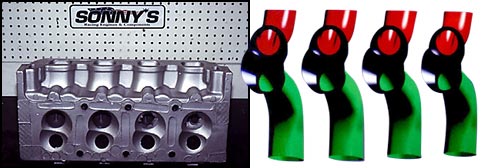|

IT'S NOT A HEMI, IT'S A CHEVY...SORT
OF!

DRO is going to have an in-depth article on
the new generation Sonny Leonard Chevy motor
in the August issue, but we couldn't resist
giving you a little sneak peek at the cylinder
heads in their raw state. So here you go. By
the way, while we were there Sonny was testing
one of the motors for IHRA racer John Montecalvo
on the dyno and it made over (way over) 1700
hp and 1200 lbs of torque on a day when the
air was terrible. [7-14-2003]
CUBIC INCHES DO MAKE A DIFFERENCE!
DRO was at Sonny Leonard's Lynchburg, VA shop
for a dyno test of Leonard's new generation
Chevy engine with heads that feature 180-degree
opposed valve position, but without a hemispherical
combustion chamber. During the test, the subject
of Leonard's new 737 cubic inch nitrous Pro
Mod motor came up. Sonny told DRO that his 737
engine makes 100-125 hp more than the 710 inch
engines he has built in the past. DRO relayed
to Sonny that both Rickie Smith and Shannon
Jenkins told DRO that more cubic inches wouldn't
make a difference in horsepower. The famed engine
builder just laughed at that suggestion. DRO
did see that three or four of the 737 engines
were in the process of being assembled. [7-14-2003]
NUMBERS IN THE NEWS
When was the last time a Pro Modifed's winning
time at an IHRA or NHRA National event was in
the 6.50s? When was the last time the low qualifier
was in the 6.30's? At the just-
ADVERTISEMENT
 |
|
completed
IHRA National Event at Milan, MI. [7-14-2003]
INTO THIN AIR?
With the NHRA in Denver for the Mile-High Nationals, the question of altitude and oxygen is sure to be on the racers' minds. The naturally-aspirated engines in Pro Stock may be most affected as they strain to create horsepower.
Warren Johnson estimates that the cars lose between 250 and 300 horsepower running in the thin air, which means that they don't run as fast as at other tracks.
"Today's engines are different," WJ explained," so you have to adjust accordingly. This includes changes in the gearing as well as the mixture to the carburetor. The lack of power also means you can't use the same suspension set-up as you do at sea level. From a performance standpoint, it's certainly not as fast as we like, but on the competitive side, I don't care if it takes an hour to cross the finish line, as long as I get there first."
Johnson quipped, "You know you're in trouble
when you get to town and the air is so thin
that even the birds are walking." Man, the Professor
cracking a joke . . . maybe the thin air affects
more than the engines. [7-14-2003]

|